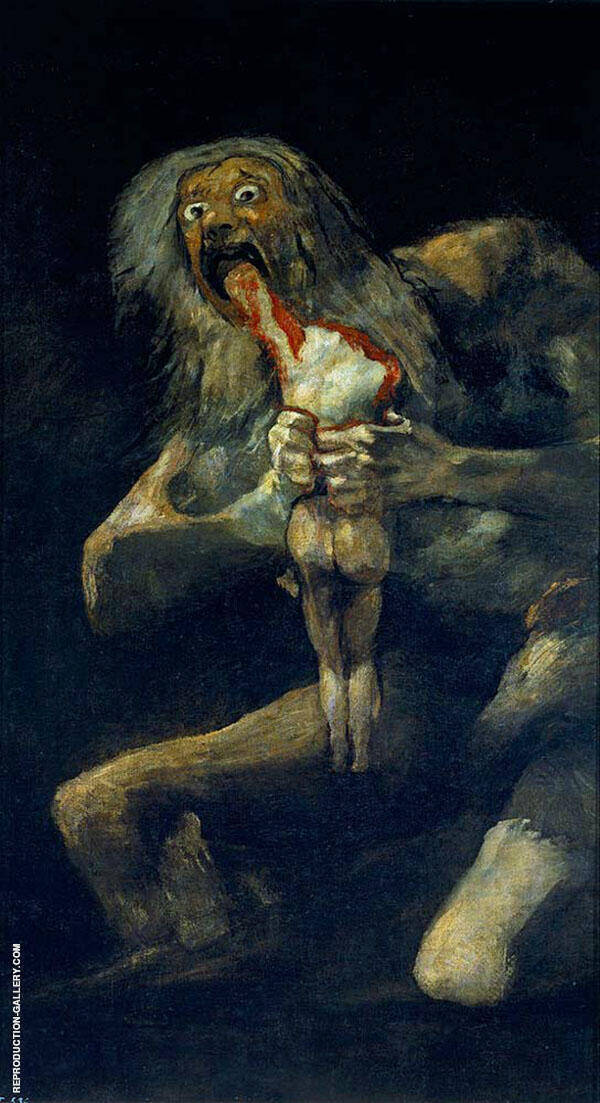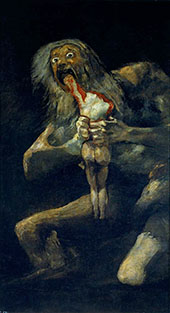Saturn Devouring his Son By Francisco Goya
Saturn Devouring His Son, by Francisco de Goya, stands out as the artist's most famous painting.
Depicting the Greek myth of the Titan Cronus eating his son (better known as Saturn in Roman mythology), it’s a genuinely violent and shocking image.
Why did Francisco de Goya paint Saturn Devouring his Son?
Between 1819 and 1823, Goya painted a uniquely disturbing series of murals on the walls of his home. Unfortunately, he never wrote about his reasons for creating the artworks or even gave the titles of the paintings. Despite this, they offer fascinating insights into the artist’s state of mind.
Goya purchased a property in 1819 named “Quinta del Sordo.” Translated as Villa of the Deaf Man, this title was particularly fitting for Goya. Named after a previous deaf occupant, Goya also suffered from hearing problems after a fever in 1792.
His murals utilized mixed media, adorning almost every room in the villa. Art historians believe Goya originally decorated the various rooms with more uplifting imagery in bright colors. Over the years, however, he painted over these artworks with the darker images we see today.
Created entirely for Goya’s delight (there was no external commission or discussion on the murals), they accurately reflect his troubled mind. Indeed, this period of Spanish history witnessed war, violence, and terror fueled by the Spanish Inquisition.
Why did Saturn eat his sons?
In Goya's painting, Saturn Devouring His Son, the Greek Titan Cronus (or the Roman God Saturn) feared murder at the hands of his children. So, after hearing a prophecy foretelling his demise, he consumed each child moments after their birth.
The Roman myth told how Saturn previously overthrew his father (Caelus). Saturn ate his children, including Vesta, Dis, Ceres, Juno, and Neptune. After this bloodshed, however, his wife hid their sixth child (Jupiter) on the island of Crete.
To fool Saturn, she gave him a stone wrapped in children’s swaddling to eat. Realizing Saturn’s worst fears, Jupiter eventually overthrew his father, just as the fates predicted.
In an intriguing detail, mythology usually describes Saturn swallowing his children whole. However, he later regurgitated each child alive after eating the fateful stone.
Goya changes this detail, however, depicting a ruthless God chewing on a naked body. He’s already bitten off the head (and probably the right arm, too) and is currently gnawing on the figure’s left arm.
However, art historians have questioned the age of the dead figure (placing doubt on the link with the myth of Saturn) as the body appears fully grown. As Goya didn’t leave written evidence or titles for his works, this will ultimately remain an art historical mystery.
What is the message in Francisco Goya's famous paintings?
The Goya oil paintings in Quinta del Sordo are particularly oblique in their meanings. The subject matter and dating have been the subject of much conjecture for centuries.
Painted in Goya’s dining room, Saturn looms from the darkness. His eyes bulge madly, and his mouth gapes wide open. The only brightness in the mural comes from the bright red blood dripping down the victim’s body, the white flesh, Saturn’s eyes, and gnarled knuckles.
This depiction may represent a message of “youth against old age” or time as the inevitable devourer of life. During this period, Goya lived with his young housekeeper (and possibly mistress). His aging and ill health increasingly played on his mind.
God's implacable wrath and punishment is an appealing theory for a country going through the Spanish inquisition. Given the wars and violence occurring in Spain at the time, the painting could also serve as an allegory for the fatherland eating its children.
Other interpretations point toward Goya’s son (Xavier). As the only one of Goya’s six (known) children to survive, this provides a fascinating parallel with the Greek and Roman myths.
Artistically, Goya may have also seen Peter Paul Rubens’ Saturn Devouring His Son (1636). Hanging in the Museo del Prado, Rubens’ version is less directly ferocious than Goya’s. Nonetheless, it depicts a calculating and malicious Saturn devouring his infant son (this time represented as a baby). The flesh stretching from the baby’s chest into the old man’s bearded mouth is especially gruesome.
Is Francisco de Goya's oil painting an example of Romanticism?
Goya black paintings are genuinely original and unique examples of Romanticism. They also demonstrate the cross-over into Realism championed by painters like James McNeill Whistler.
As an artistic movement, Romanticism emphasized individual emotion and intuition. It was highly suspicious of scientific logic and deductive reasoning. Art had to originate from the personal imagination of the artist, unconstrained by artificial rules and technical styles.
Artists working in the genre (with Goya as a prime example) focused on ancient narratives and intense emotion. Saturn Devouring, His Son, is particularly representative of the movement’s emphasis on powerful negative emotions such as awe, terror, horror, and fear.
For Goya, these emotions originated from our direct relationship with the sublime and nature. In addition, he had a deep-seated personal fear of madness, and these feelings are especially evident in the Black Paintings series.
What are Francisco Black Paintings?
The “Black Paintings” refer to a group of fourteen Francisco de Goya paintings created during his later years.
There has been some speculation surrounding whether Goya painted the artworks. His authorship is convincingly demonstrated by multiple scholars, however.
Painted directly onto the walls of his villa, they employ an unusual color palette consisting almost exclusively of blacks and browns. The contrast with Goya’s sunny earlier works (mainly portraits such as The Marquesa de Pontejos and The Kite) explains the widespread shock at these artworks. Interspersed by the tiniest specks of whites and greens, the ominously dark and gloomy effect is overpowering.
Transferred onto canvas after Goya died, the murals now hang in the Museo del Prado in Madrid, Spain. The Belgian banker and Consul Emile d’Erlanger purchased the property in 1874, ordering their removal shortly after.
This act has since met with controversy. Although overseen by the chief art restorer at the Museo del Prado (Salvador Martinez Cubells), at least one critic has described the act as “hacking” the murals off the walls.
Today, the paintings are in relatively poor condition, resulting in the loss of much original detailing. Despite this, Goya's famous painting, Saturn Devouring His Son has fared the test of time much better than many of his other murals.
Buy Goya's painting Saturn Devouring his Son from our online catalog of famous art reproductions.
We offer a 100% money back guarantee or replacement service. If for any reason you are dissatisfied with your painting please contact us within 7 days of receipt, advising the reason you are unhappy and we will provide you with all the information you need for its return or replacement.
We ship free to anywhere in the world via FedEx or DHL expedited service with online tracking.
Your painting will be shipped rolled in strong plastic tubing, ready for stretching and/or framing locally. This is the conventional method of transporting hand-painted oil on canvas. Learn more about how your painting is shipped.
We are able to offer a framing service intercontinental U.S. Please contact us if you would like a quotation. Alternatively, should you prefer, we can recommend a framer in your area.
Notes About Your Painting
Please note that replica oil paintings are finished with an additional 10cm (4") of extra canvas on all sides, allowing ample surplus canvas for stretching and framing.
Recently Viewed:
Cannot Find What You Are Looking For?
Reproduction Gallery Information
Customer Service
(Send Us A Message)
Tel: (503) 937 2010
Fax: (503) 937 2011







